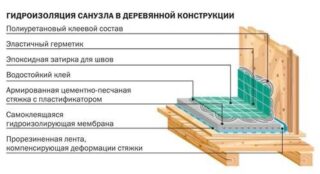Floor arrangement is one of the stages of interior decoration. The use of boards creates a warm, durable and wear-resistant coating, but it has the disadvantage of being sensitive to moisture. In order for a wooden floor to serve for many years, it must be protected from negative factors. You can choose one of the types of waterproofing and do the installation yourself.
The need to waterproof the floor in a wooden house
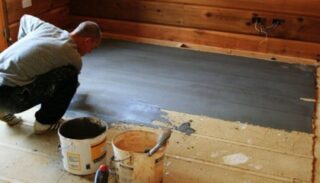
Wood is a hygroscopic material that easily absorbs and releases moisture. It absorbs water and steam in the air. A constant excess of normal humidity levels leads to negative consequences:
- The linear dimensions of the boards change - when wet, they swell, increasing their dimensions. After drying, they shrink sharply. Such vibrations lead to deformation and cracking. Due to the movement, the fastening deteriorates, the boards loosen and begin to creak.
- The vital activity of harmful microorganisms is activated - moisture is a favorable environment for fungus and mold. They hit the boards, reducing their durability.
The waterproofing of the floor protects it from the penetration of any kind of moisture: coming through the capillaries of concrete, from soil evaporation that forms in the premises. Roll, coating and coloring materials create a water-impermeable barrier.
System design
The durability of the use of flooring and thermal insulation materials depends on the quality of waterproofing work. Protection of the structure from moisture begins at the stage of construction of the foundation and basement floor. Insulation on the outside of the house prevents the penetration of melt water and precipitation. On the inside, it is also necessary to exclude the possibility of getting wet from groundwater. The coating regularly comes into contact with moisture in the kitchen, washrooms and bathrooms. In such rooms, protection is required not only from the side of the ground, but also from the room itself.
One of the important stages of work is the impregnation of logs and boards with antiseptic compounds. This is the best way to prevent water, mold and mold damage to wood. A feature of floor insulation in a wooden house is the creation of a seamless layer adjacent to the walls.
Varieties of waterproofing materials
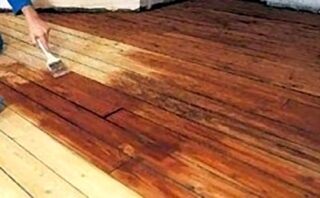
A wide range of materials is available for the construction of a waterproofing barrier. The choice depends on the design of the base, the purpose of the room and the type of finish floor covering. Before buying, you need to study the characteristics of all materials, the advantages and disadvantages of waterproofing methods:
By coloring
The technology of protecting the structure with the help of painting involves the use of polymer and bitumen varnishes, stains. In order for the effect of the composition to be effective, it is applied to all surfaces, without exception, in 2-3 layers. In this case, the tree must be dried, the percentage of moisture is no more than 8-10. Water-repellent paints are applied with a brush. First, the individual parts are processed, after the coating is laid, the finishing application is carried out. The disadvantage of this method is a short service life, after 5-7 years, the layer must be renewed.
Lubricating insulation
One of the most popular and effective options was the coating waterproofing of a wooden floor arranged in a private house. It is performed with mastic compositions based on acrylic, latex or modified bitumen. Modern materials are one-component and two-component. They do not require heating to a high temperature like bitumen, therefore they do not pose a fire hazard.
The materials form an elastic water-repellent film. A sealed seamless flooring is the best option for treating the bathroom floor, it can be laid on tiles. The mastic is applied to the entire surface, extends to the walls to a height of 20 cm. It is recommended to apply several layers. The disadvantages include an unpleasant smell and duration of work. The application of new layers of mastic is possible only after the previous ones have completely dried.
Cast
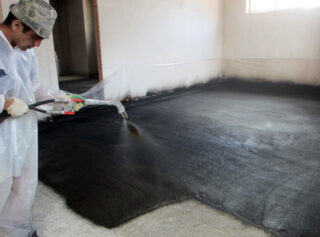
Application of the technology gives a monolithic surface resistant to moisture. Cast insulation is applied hot and cold. The most common materials for its construction are asphalt concrete, bitumen, pitch. The base for pouring requires careful preparation. It is repaired, cleaned, dried. Insulating materials require heating up to 70-90 ° C. After filling the entire base, the layer is leveled with a metal scraper. The main disadvantage of the technology: high cost.
Bulk
When installing the floor on the ground, this option is the most budgetary and practical. Bentonite is used as bulk insulation - a mixture of sand and polymer components. The material is poured into a specially made formwork or between the joists. It is carefully compacted and leveled. When water is added, a gel-like mass is formed, which, after drying, becomes waterproof. The advantages of bentonite include thermal insulation properties, ease of installation and affordable cost. Slag, perlite, foam granules can serve as backfill.
With pasting
Liquid rubber
Using liquid rubber is an economical and quick way to create a waterproof coating. The material does not need heating, it is applied with a brush or spatula. It is a two-component compound that is miscible with water, so it is safe for health and odorless. Bituminous-polymer mastic is durable, elastic and durable. When dry, it forms a sealed, seamless layer.
Liquid rubber is recommended for waterproofing a bathroom, bathroom, porch, shower room or basement - all rooms with high humidity. The composition has excellent adhesion to wood and concrete.
Preparatory work
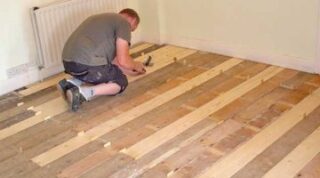
For any type of waterproofing, you need to prepare a base. If this is an old floor, a major revision is required. Finishing and roughing boards are dismantled and inspected, material with signs of rot is replaced with a new one. The logs are carefully inspected, usually after minor repairs and filling the cracks, they can be reused.
If the floor is being laid for the first time, work begins with waterproofing the posts made of brick or concrete, on which the logs rest. The props are covered with a layer of bituminous mastic.Roofing material is laid on top in 2-3 layers to prevent capillary wetting of the log. For the base of the floor, a dry timber with a section of 40-70 × 100-200 mm is used. On the sides, cranial bars are nailed to them for the installation of rough boards or moisture-resistant plywood.
Before laying, all lumber is treated with antiseptics and deep penetration impregnations. Low quality boards are suitable for rough flooring. All construction waste is removed from the surface of the finished floor. Wooden elements and walls up to a height of 20 cm are treated with a bituminous primer or another compound recommended by the manufacturer for the selected type of waterproofing. The priming solution is applied with a brush, the joints of the floor and walls are well covered. Further work is started after the primer has dried.
Required tools and materials
A set of tools and materials for pasting waterproofing:
- construction knife;
- roller or brushes;
- roulette;
- antiseptic;
- roll insulation;
- bituminous mastic;
- bituminous or polyurethane adhesive.
In some cases, a high density polyethylene film is used as a waterproofing sheet. It is also advisable to install a vapor barrier membrane. It will prevent the insulation from getting wet.
DIY installation features
- The sheets of the required length are cut from the roll of insulating material.
- The rough flooring and joists are covered with a layer of bitumen mastic, which will ensure the fixation of the roll insulation.
- The cut fabric is pressed tightly to the base, rolled with a special roller so that no air remains. The next strips are laid with an overlap of 10-15 cm, the edges are smeared with mastic.
- Insulation is placed on the waterproofing layer - slabs of basalt wool or pneopolystyrene. They should not reach the edge of the log so that there is a ventilation gap.
- The insulation is covered with a vapor barrier membrane, which will prevent condensation from falling out. The smooth side of the web is directed inward.
- The flooring is assembled from finishing boards. The final stage of waterproofing the floor is their treatment with polyurethane or bituminous varnish.
Floor waterproofing is a mandatory step in building a house. If you exclude the processing of materials and structures with compounds that protect against moisture, the coating will quickly become unusable. Expensive repairs and replacement of the floor will be required.

